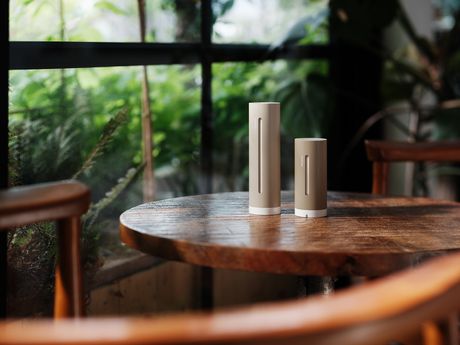
Netatmo dévoile la nouvelle Station Météo ORIGINAL

Jusqu'à -50% sur une sélection de produitsAcheter

Il n’est pas encore totalement entré dans les mœurs de mesurer le taux d’humidité de la maison. C’est de plus en plus fréquent, mais ce n’est pas comme mesurer la température. On associe souvent confort et température justement, mais ce n’est pas le seul facteur ! Si la température est idéale, encore faut-il que le taux d’humidité, d’hygrométrie ou d’humidité relative soit également régulé.
C’est une donnée qui varie beaucoup selon les différents logements, mais aussi en fonction de vos habitudes et du moment. Pourtant, c’est une véritable question de santé : comme vous le lirez plusieurs fois plus bas, un taux d’humidité supérieur aux valeurs recommandées ou au contraire trop bas peut être à l’origine de problèmes de santé chez les humains, animaux ou végétaux. Il peut également être à l'origine de l'insalubrité du logement.
Contrôler ce taux d’humidité pour améliorer votre confort comme votre santé passe donc par sa mesure précise. Sans ces données, impossible d’améliorer la situation. Heureusement, il existe comme pour la température des appareils capable de mesurer le taux d’humidité : il s’agit des outils de mesure de l’hygrométrie.
La Station Météo Intelligente Netatmo ne fait pas que mesurer le taux d’humidité. Connectée, elle vous fournit toutes les informations qu’il vous faut pour maintenir l’air de votre logement sain. En plus, vous recevez ces données directement sur votre mobile et vous recevez des alertes lorsqu’il devient utile d’aérer !
L’hygromètre est un appareil fonctionnant comme un testeur d’humidité. Pour mesurer le taux d’humidité à l’intérieur de votre logement, tout commence donc par cet humidimètre : c’est la solution la plus simple même si elle nécessite l’achat de l’appareil.
Notez que dans cet article, nous utilisons le terme de taux d’humidité pour évoquer l’humidité relative (qui est une estimation du taux de saturation de l'air en vapeur d'eau), ou taux d’hygrométrie. De même, les notions d’humidimètre et d’hygromètre sont identiques.
L’hygromètre mesure donc les taux d'humidité entre 0 % (pour un air très sec) et 100 % (vapeur d’eau visible sous forme de brouillard ou de gouttes). Votre testeur d’humidité est en effet un outil qui vous aide à mesurer précisément le pourcentage de vapeur d’eau qui se trouve dans l’air de votre maison. C’est un allié de choix dans la guerre contre l’humidité et la lutte pour un air sain, pur et de qualité !
Une station météo fournissant des données intérieures grâce à des capteurs dans la maison est également une excellente solution permettant d’aller plus loin qu’avec un simple hygromètre. C’est un outil plus complet, souvent connecté, qui permet de disposer d’une vision plus large et plus détaillée de l’humidité dans la maison.
Enfin, une dernière option vraiment efficace vous est proposée : il s’agit tout simplement de faire appel à un professionnel de l’hygrométrie ou de l’humidité. Ce spécialiste (ou cette société spécialisée) pourra vous expliquer clairement et de façon sûre les sources d’humidité de votre logement ainsi que les solutions les plus adaptées pour rétablir un taux convenable.
Contrôlez avec précision l'environnement intérieur de votre maison avec la Station Météo Intelligente Netatmo. Mesurez, analysez et comprenez votre taux d’humidité en plus de la qualité globale de votre air. Diminuez à la fois un taux d’humidité trop élevé et la pollution intérieure.
Il existe bel et bien un taux d’humidité (ou taux d'hygrométrie) idéal à conserver dans un logement. Pourquoi et surtout, quel est ce taux ?
En effet, il en va de votre santé, mais aussi de celle de votre maison et de tout ce qui est à l’intérieur. Un taux d’humidité trop élevé entraîne de la condensation sur les fenêtres, de la moisissure dans la salle de bain ou encore des allergies. Un taux d’humidité trop faible peut causer une peau sèche, des irritations du nez ou de la gorge et un inconfort permanent.
Le taux d’humidité au même endroit évolue au cours de la journée. En effet, cela est lié aux changements de température : l’air froid retient moins la vapeur d’eau que l’air chaud, c’est pourquoi la nuit, le taux d’humidité relative a tendance à augmenter car la température baisse.
Pour éviter au maximum les effets indésirables et néfastes sur la santé comme sur l’intérieur du logement, il est recommandé par les experts de conserver un taux d’humidité compris entre 45 et 50 %.
C’est ce pourcentage de vapeur d’eau dans l’air qui représente le meilleur compromis. Pour maintenir ce pourcentage d’humidité relative, l’idéal est de mesurer en continu le taux à l’aide d’un hygromètre ou d’une station météo intérieure.
Des estimations plus larges recommandent un taux d’humidité relative correct entre 40 et 65 % : tant que l’air intérieur de la maison reste dans cette fourchette, la vapeur d’eau (ou son absence) n’entraîne pas d’effets négatifs.
Attention, notez qu’il est important d’agir rapidement lorsque le taux d’hygrométrie dépasse les 70 % ou qu’il est inférieur à 30 %. Ces valeurs sont des indicateurs fiables à connaître pour améliorer l’atmosphère de votre logement.
Les problèmes d’humidité (excès ou manque) sont fréquents. Pourtant les solutions pour en venir à bout sont efficaces ! Alors ne vous sentez plus désemparé(e) et commencez la mesure du taux d’humidité afin de l’optimiser. Hygromètre, station météo, professionnel…choisissez la solution qui vous correspond.